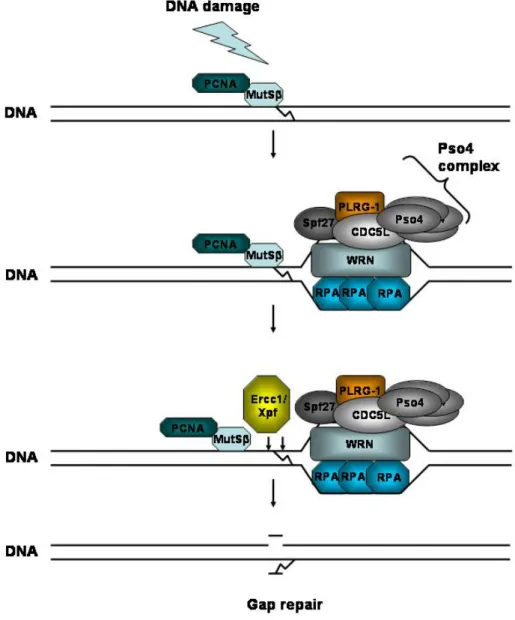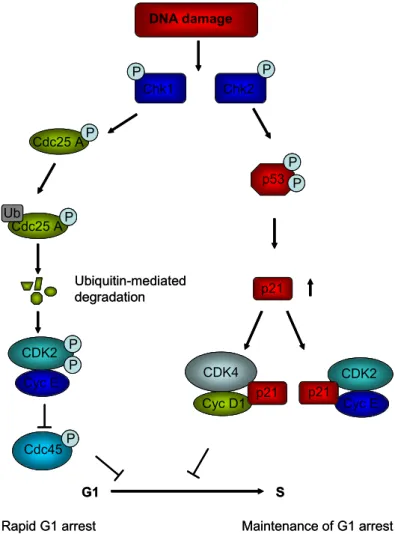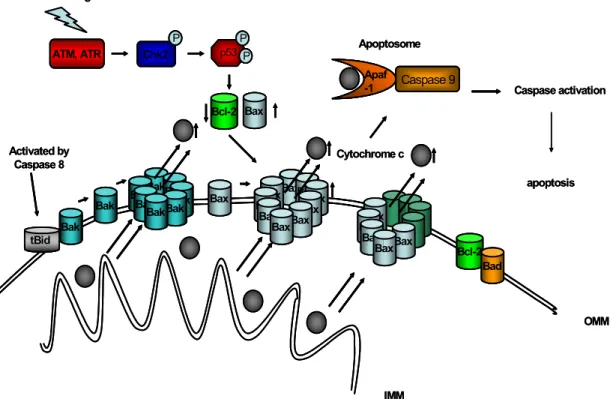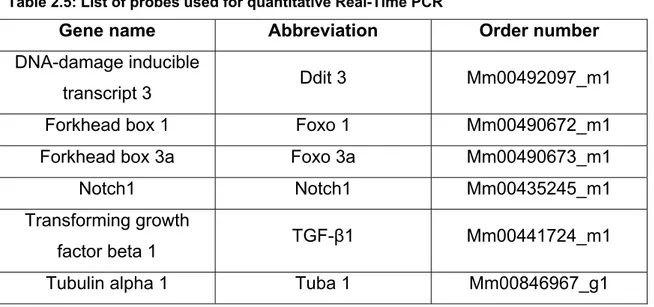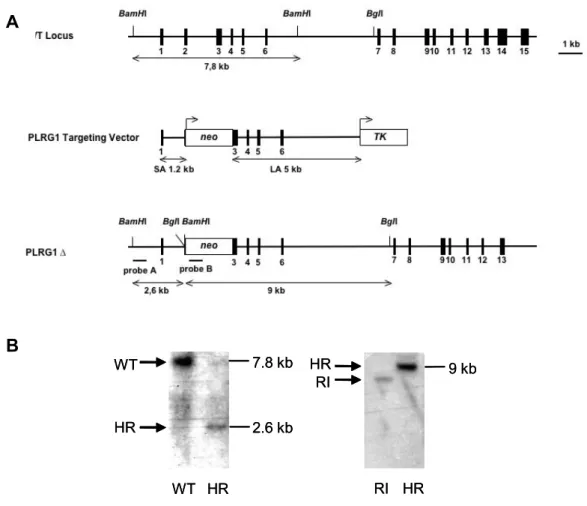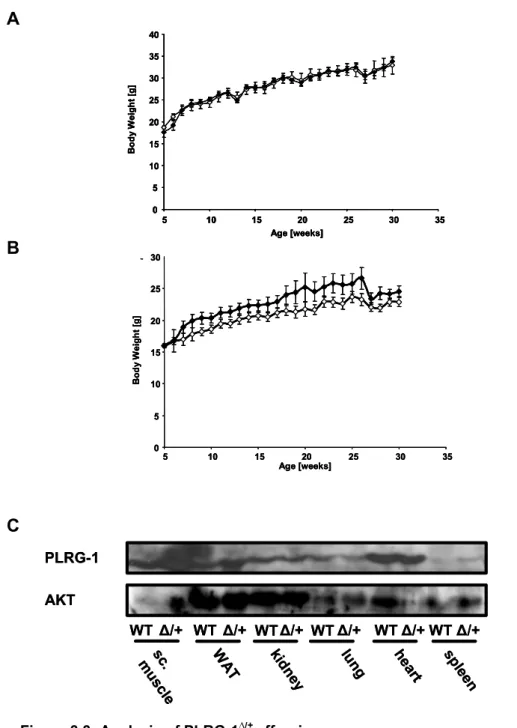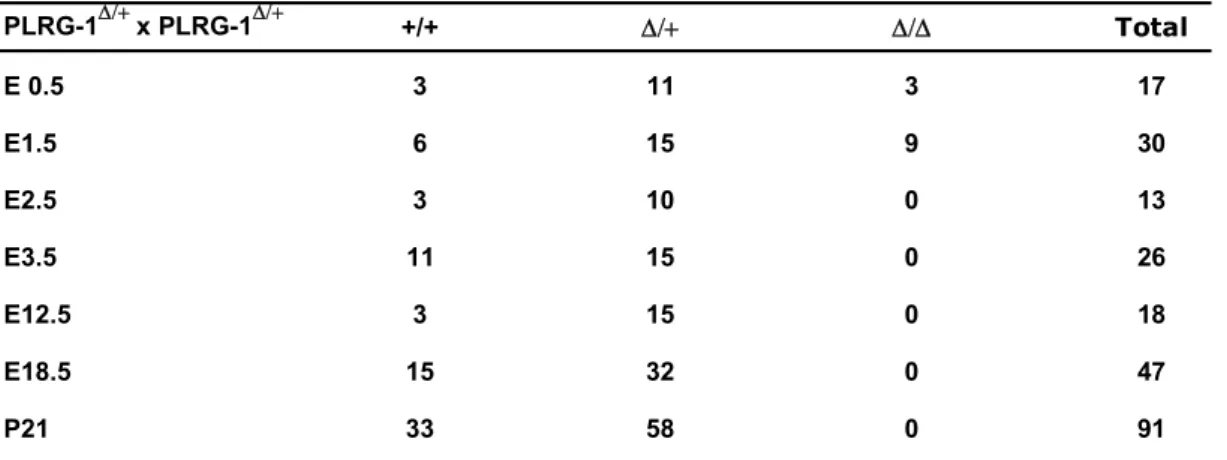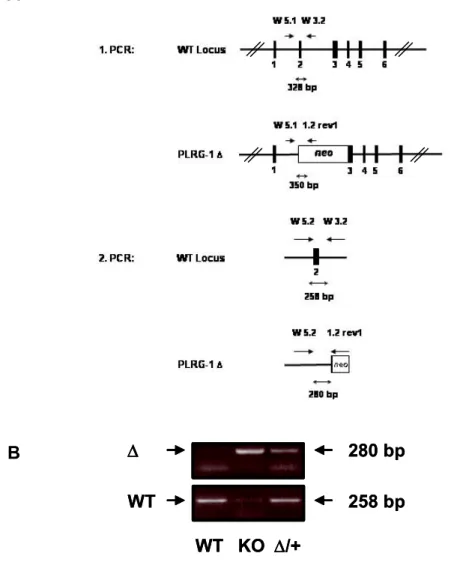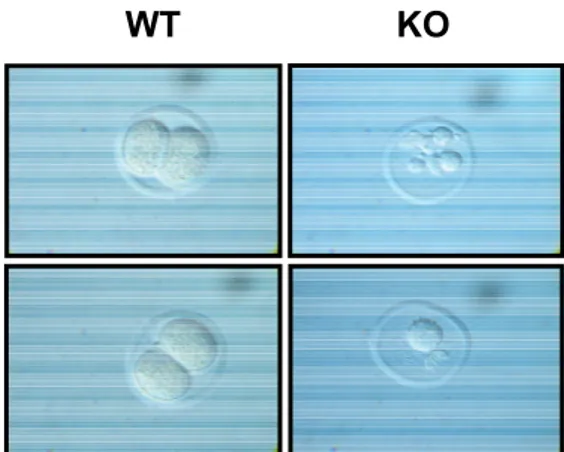Inactivation of Pleiotropic Regulator 1 reveals p53-dependent Control of Cell Proliferation and Apoptosis by the Pso4-
complex
Inaugural-Dissertation zur
Erlangung des Doktorgrades
der Mathematisch-Naturwissenschaftlichen Fakultät der Universität zu Köln
vorgelegt von André Kleinridders
aus Krefeld
Köln 2007
Berichterstatter: Prof. Dr. Jens Brüning Prof. Dr. Thomas Langer
Tag der mündlichen Prüfung:_________09. Juli 2007 ________________
Für Tina
„Darin besteht das Wesen der Wissenschaft. Zuerst denkt man an etwas, das wahr sein könnte. Dann sieht man nach, ob es der Fall ist und im allgemeinen ist es nicht der Fall.“
Bertrand Russell (1872-1970), brit. Philosoph und Mathematiker, 1950
Nobelpreis für Literatur
Table of contents
Table of contents
Table of figures ... IV List of tables ... VI Abbreviations ... VII
1 Introduction ... 1
1.1 PLRG-1, an evolutionary conserved component of the spliceosome 1 1.2 Regulation of pre-mRNA splicing ... 2
1.3 Role of PLRG-1 in DNA repair ... 6
1.4 DNA damage leads to cell cycle arrest ... 9
1.5 Regulation of apoptosis in DNA damage and repair ... 14
1.6 Involvement of the Bcl-2 family in the regulation of apoptosis... 16
1.7 Objectives ... 19
2 Materials and Methods ... 20
2.1 Chemicals and antibodies ... 20
2.2 Molecular biology ... 22
2.2.1 Competent E.coli and isolation of plasmid DNA ... 22
2.2.2 Construction of targeting vectors ... 22
2.2.3 TA-cloning ... 24
2.2.4 Generation of gene replacement vectors... 24
2.2.5 Isolation of genomic DNA ... 24
2.2.6 DNA electrophoresis... 25
2.2.7 Pulsed-field gel electrophoresis ... 25
2.2.8 DNA sequencing ... 26
2.2.9 Quantification of DNA... 26
2.2.10 PCR ... 26
2.2.11 RT-PCR and quantitative Real-Time PCR ... 29
2.2.12 DNA hybridization ... 31
2.2.13 Northern Blot and RNA hybridization... 31
2.3 Cell culture ... 32
2.3.1 Primary embryonic fibroblast (EF) culture ... 32
2.3.2 Embryonic stem (ES) cell culture ... 33
2.3.3 HTN-Cre-mediated deletion in vitro ... 34
2.3.4 Cell cycle analysis ... 34
2.3.5 Cell cycle analysis using fluorescence-activated cell sorter (FACS) analysis... 34
3
2.3.7 Analysis of apoptosis ... 35
2.3.8 DNA double-strand breaks after UV-treatment ... 36
2.3.9 Immunofluorescence ... 36
2.3.10 RNA interference (RNAi) ... 37
2.4 Biochemistry ... 37
2.4.1 Protein extraction from tissue... 37
2.4.2 Protein extraction from cells ... 37
2.4.3 Nuclear and cytoplasmic protein extraction ... 38
2.4.4 Immunprecipitation ... 38
2.4.5 Western Blot ... 39
2.4.6 Immunohistochemistry ... 40
2.5 Statistical methods ... 40
2.6 Animal Care ... 41
2.6.1 Mouse experiments ... 41
2.6.2 Mice ... 41
3 Results... 42
3.1 Murine expression pattern of PLRG-1... 43
3.2 Generation of a conventional PLRG-1 gene replacement vector... 44
3.3 Analysis of PLRG-1 ∆/+ mice... 46
3.4 PLRG-1 ∆/∆ mice are embryonic lethal... 47
3.5 Generation of a conditional PLRG-1 gene replacement vector ... 50
3.6 Inactivation of PLRG-1 in mouse embryonic fibroblasts blocks cell proliferation ... 53
3.7 PLRG-1 deficiency prevents S-phase entry... 55
3.8 PLRG-1 deficiency increases p53 expression and induces apoptosis ... 57
3.9 No evidence for altered splicing in PLRG1-deficient MEFs ... 60
3.10 PLRG-1-deficient MEFs exhibit no spontaneously detectable DNA double-strand breaks... 62
3.11 PLRG-1 deficiency results in enhanced γ-H2AX phosphorylation . 63 3.12 Conditional inactivation of PLRG-1 in heart and skeletal muscle .. 64
3.13 Conditional inactivation of PLRG-1 in heart results in dilated cardiomyopathy due to increased cardiomyocyte apoptosis... 66
3.14 Conditional inactivation of PLRG-1 in the central nervous system of mice results in early postnatal lethality ... 68
3.15 Neuron-restricted PLRG-1 deficiency results in massive neuronal apoptosis ... 69
3.16 Interaction of the nuclear CDC5L-PLRG-1 complex with the p53 phosphatase WIP1 is disrupted in the absence of PLRG-1... 71
3.17 Rescue of the apoptotic PLRG-1 phenotype by knockdown of p5373
4 Discussion ... 77
Table of contents 4.1 Essential role for PLRG-1 in the development of the preimplantation
murine embryo... 77
4.2 Disruption of other splicing factors and their effects ... 78
4.3 Function of PLRG-1 orthologues ... 79
4.4 PLRG-1 in control of cell cycle and apoptosis... 80
4.5 Impaired DNA damage repair as a consequence of PLRG-1 deficiency ... 83
4.6 Proposed model for PLRG-1, linking DNA repair, control of cell cycle progression and apoptosis via the Pso4-complex ... 85
5 Summary... 89
6 Zusammenfassung ... 90
7 Kurzzusammenfassung... 91
8 References... 92
9 Acknowledgements ... 115
10 Versicherung ... 116
11 Lebenslauf ... 117
Table of figures
Figure 1.1: Schematic representaion of splicing reaction...5
Figure 1.2: Schematic representation of the Pso4-complex in ICL repair....8
Figure 1.3: Schematic representation of DNA damage checkpoint pathway...9
Figure 1.4: Schematic representation of the G 1 /S checkpoint...11
Figure 1.5: Apoptosis signalling in response to p53 activation...18
Figure 2.1: Schematic representation of semi-nested PCR method...28
Figure 3.1: Ubiquitous expression of PLRG-1...43
Figure 3.2: Conventional inactivation of the PLRG-1 gene...46
Figure 3.3: Analysis of PLRG-1 ∆/+ offspring...47
Figure 3.4: Identification of genotype using semi-nested PCR...49
Figure 3.5: Representative morphology of wild type and PLRG-1-deficient embryos at ED1.5...50
Figure 3.6: Conditional inactivation of the PLRG-1 gene...52
Figure 3.7: Verification of PLRG-1 deletion in MEFs upon HTNC treatment...53
Figure 3.8: Growth rates and morphology of untreated or Cre-treated wild type and PLRG-1 flox/flox MEFs...55
Figure 3.9: FACS analysis of serum (FCS)-stimulated cell cycle progression in control and PLRG-1-deficient MEFs...56
Figure 3.10: 3 H-thymidine incorporation of wild type and PLRG-1-deficient MEFs...57
Figure 3.11: Western blot analysis of HTNC-treated wild type (WT) and PLRG-1 flox/flox MEF (KO)...59
Figure 3.12: TUNEL analysis of wild type and PLRG-1-deficient MEFs...60
Figure 3.13: Splicing in PLRG-1-deficient MEFs is unaltered...61
Figure 3.14: Pulse-field gel electrophoresis of PLRG-1 flox/flox (control) and PLRG-1-deficient MEFs (KO)...62
Figure 3.15: Analysis of γ-H2AX phosphorylation in untreated and HTNC-treated PLRG-1 flox/flox MEFs...63
Figure 3.16: Heart-restricted PLRG-1 deficiency in PLRG-1 mus mice...65
Table of figures Figure 3.17: Survival rate of control and PLRG-1 ∆mus mice...65 Figure 3.18: Heart-phenotype of PLRG-1 ∆mus mice...66 Figure 3.19: Histological analysis of control- and PLRG-1 ∆mus -hearts at the age of 24 days...67 Figure 3.20: Western blot analysis of control (C) and
PLRG-1 ∆mus -(KO) hearts...68 Figure 3.21: Survival rate of control and PLRG-1 ∆CNS mice...69 Figure 3.22: Analysis of neuron-restricted recombination of the
PLRG-1 flox/flox allele...69 Figure 3.23: Immunohistochemical analysis of brains dissected from 3-day-old control and PLRG-1 ∆CNS mice...70 Figure 3.24: Western blot analysis of control (C) and PLRG-1 ∆CNS (KO) hearts...71 Figure 3.25: CDC5L and WIP1 fail to form complexes in the nucleus of PLRG-1-deficient MEFs...73 Figure 3.26: Rescue of the apoptotic PLRG-1 phenotype by
knockdown of p53...74 Figure 4.1: Schematic representation of G1/S-phase progression
and block...81 Figure 4.2: Proposed model for novel integration of pre-mRNA
splicing components linking DNA repair, and control of cell cycle
progression and apoptosis via CDC5L-PLRG-1 interaction...87
List of tables
Table 2.1: Chemicals...20
Table 2.2: Oligonucleotides used for generation of gene replacement vectors and probes for Southern and Northern Blot...22
Table 2.3: List of primers used for genotyping...28
Table 2.4: List of oligonucleotides used for amplification of cDNA...30
Table 2.5: List of probes used for quantitative Real-Time PCR...30
Table 2.6: Antibodies used for biochemical studies...39
Table 3.1: Genotype analysis of PLRG-1 ∆/+ -intercross offspring based on a semi-nested PCR approach...48
Table 3.2: Genotype analysis of mice obtained from breedings of PLRG-1 flox/flox mice with PLRG-1 flox/+ MCKCre mice...64
Table 3.3: Genotype analysis of mice obtained from breedings of
PLRG-1 flox/flox mice with PLRG-1 flox/+ SynCre mice...68
Abbreviations
Abbreviations
A adenosine
aa amino acid
AP apurine / apyrimidine
BAC bacterial artificial chromosome
bp base pairs
BSA bovine serum albumin C control
°C temperature in degrees celsius
cDNA complementary DNA
CO 2 carbondioxide
cps counts per second
Cre causes recombination, recombinase from phage P1 C-terminal carboxy-terminal
d day/s
DEPC diethylpyrocarbonate
DNA desoxyribonucleic acid
dNTP desoxyribonucleotide-triphosphate DMEM Dulbecco’s modified Eagle medium
DMSO Dimethyl sulfoxide
DTT 1,4-Dithio- DL-threitol E. coli Escherichia coli
ECL enhanced cheminoluminescence
ED embryonic day
EDTA ethylene-diaminetetraacetic acid
EF embryonic fibroblasts
ES embryonic stem cells
EtBr ethidiumbromide EtOH ethanol
F farad
FACS fluorescence activated cell sorting
FCS foetal calf serum
flox lox P flanked
Flp site-specific recombinase, product of yeast FLP1-gene FRT Flp recombination target
g gram G guanosine GANC ganciclovir
G418 geneticin sulfate
h hour/s
HCl Hydrogenchlorid
HEPES N-2-hydroxyethylpiperazine-N’-2-ethanesulfonic acid
HR Homologous recombinant
HSV-tk Herpes simplex virus-thymidine kinase
ICL Interstrand crosslinks
LA long arm of homology LIF leukaemia inhibitory factor
Kb Kilobase pairs
KCl potassium chloride
kD/kDa kilodalton
loxP recognition sequence for Cre (locus of x-ing over of phage P1) M molar
MCK Muscle creatinine kinase MgCl 2 magnesium chloride
min minute
ml milliliter mM millimolar
MMC mitomycin C
µg microgram µl microliter µM micromolar
NaCl sodium chloride
NaF sodium fluoride
NaOH sodium hydroxide
Na 3 O 4 V sodium orthovanadate
Abbreviations neo neomycin resistance gene
N-terminal amino-terminal
OD optical density
OH hydroxyl PBS Phosphate buffered saline PCR polymerase chain reaction PFGE pulsed-field gel electrophoresis
RNA ribonucleic acid
rpm revolutions per minute
RS arginine/serine rich
RT room temperature
s second SA short arm of homology SDS sodium dodecyl sulfate
ss single stranded
SSC sodium chloride/ sodium citrate buffer SYN synapsin
T thymidine TAE Tris-acetic acid-EDTA buffer
Taq polymerase from Thermus aquaticus TBE Tris-acetic basic-EDTA buffer
T-DNA transfer-DNA
TE Tris-EDTA buffer
Tris 2-amino-2-(hydroxymethyl-)1,3-propandiole TWEEN polyoxyethylene-sorbitan-monolaureate U unit
UV ultraviolet V volt
WT wild type
Y pyrimidine
5´ five prime end of DNA sequences 3´ three prime end of DNA sequences
∆ knockout/PLRG-1-deleted allele
Introduction
1 Introduction
1.1 PLRG-1, an evolutionary conserved component of the spliceosome
Mammalian Pleiotropic Regulator (PLRG-) 1 is an essential component of the spliceosome. PLRG-1 belongs to a highly conserved family of seven WD40 domain containing proteins in eukaryotes (Ajuh et al., 2000; Ajuh et al., 2001). Founding members of this WD40-repeat protein family, PRL1 and PRL2, were first identified by T-DNA tagging in Arabidopsis thaliana (Nemeth et al., 1998). Mutation of Arabidopsis PRL1 confers hypersensitivity to glucose, sucrose and several plant hormones and results in transcriptional derepression of glucose and stress responsive genes (Nemeth et al., 1998). Whereas in plants the PRL genes are uniquely duplicated, in yeast, C. elegans and mammals there are only single orthologues of the Pleiotropic Regulator family which play important roles in the control of cellular homeostasis. siRNA- mediated knock-down of PLRG-1 (D1054.15) in C. elegans results in early embryonic lethality, whereas mutation of the yeast homologue YPL151c (Prp46) arrests cell proliferation causing a dual block in G 1 /S- and M-phase progression (Albers et al., 2003; Sonnichsen et al., 2005). Despite genetic studies of mutations, the exact regulatory function of PLRG-1 orthologues and the molecular mechanisms by which they integrate splicing and control cell proliferation so far remain elusive.
Human PLRG-1 has been initially identified as a subunit of spliceosomal
complexes purified from HeLa nuclear extracts by coimmunoprecipitation with
CDC5L (Ajuh et al., 2000). Later, it was observed that interaction between
PLRG-1 and CDC5L is essential for pre-mRNA processing as peptides
inhibiting complex formation of CDC5L with PLRG-1 efficiently block pre-mRNA
splicing (Ajuh and Lamond, 2003). These studies also revealed that other
proteins not directly implicated in regulation of pre-mRNA splicing, such as the
cell cycle phosphatase PPM1D/WIP1, PP1-α and the DNA-dependent kinase
(DDK)-α co-purified with the PLRG-1 containing CDC5L complex (Ajuh et al.,
and genome integrity. WIP1, a serine/threonine phosphatase, is a member of the PP2C family and was shown to be a negative regulator of p53 (Fiscella et al., 1997; Lu et al., 2004; Takekawa et al., 2000). PP1-α another serine/threonine phosphatase, plays an important role in the control of cell cycle progression and apoptosis by interacting with retinoblastoma protein (Liu et al., 1999) The other complex component, DNA-dependent kinase DDK-α, a serine/threonine kinase, is activated by DNA association and plays a role in processes such as DNA double-strand break repair, telomere maintenance and gene transcription (Boulton and Jackson, 1996; Boulton and Jackson, 1998;
Smith and Jackson, 1999; Taccioli et al., 1998).
Recently, the CDC5L-PLRG-1 complex was demonstrated to interact with the WRN protein, which is deficient in Werner syndrome and required for processing of DNA interstrand crosslinks (Zhang et al., 2005). In addition to pre- mRNA splicing, the CDC5L-PLRG-1 complex is thus possibly involved in DNA repair. Another known component of the nuclear CDC5L-PLRG-1 complex is the mammalian homologue Pso4/PRP19, which is essential both for pre-mRNA- splicing and UV-radiation mediated crosslink repair (Mahajan and Mitchell, 2003). These findings strongly suggest that the Pso4-CDC5L-PLRG-1 complex integrates pre-mRNA splicing and DNA-repair.
1.2 Regulation of pre-mRNA splicing
Most genes in eukaryotes are interrupted several times by intervening
sequences, known as introns, which are transcribed into primary messenger
RNA transcripts (pre-mRNA). For functional translation, these non-coding
sequences have to be precisely excised, generating functional mRNAs. This
task is performed by a ribonucleoprotein complex, called spliceosome. This
complex consists of five small nuclear ribonuclearprotein (SnRNP) complexes
U1, U2, U4, U5 and U6 and about 300 other non-snRNP proteins (Rappsilber et
al., 2002; Zhou et al., 2002). The spliceosome orchestrates the precise excision
of introns by several RNA-RNA, RNA-protein and protein-protein interactions. A
key feature of correct splicing is the presence of a conserved 5´ and 3´ splice
Introduction site, a branch point region usually 20-40 nucleotides upstream of the 3´ splice site and a polypyrimidine tract in the intron (Reed 1989; Smith et al., 1989;
Stephens and Schneider 1992).
For many years it was thought that the spliceosome assembles in a stepwise manner. First, U1 snRNP binds to the 5´ splice site, while the serine/arginine (SR) protein U2AF 65 binds the polypyrimidine tract and another SR protein U2AF 35 binds the 3´ splice site (Merendino et al., 1999; Wu et al., 1999; Zamore et al., 1992; Zorio and Blumenthal, 1999). This RNA-protein complex is known as the E-complex (Michaud and Reed, 1991). Then, U2 snRNP binds weakly to the pre-mRNA using the integral associated U2 snRNP protein SF3b (Hastings and Krainer, 2001). Next, U2 snRNP binds to the branchpoint region forming the A-complex, a process dependent on ATP (Furmen and Glitz, 1995; Kramer, 1996). Subsequently, the U4/U6 . U5 tri- snRNP complex adheres to the 5´ splice site by interacting with Prp8 and the pre-mRNA in the presence of ATP, thereby generating the B-complex (Brown and Beggs, 1992; Umen and Guthrie, 1995; Umen and Guthrie, 1995).
Exclusion of U1 and U4 snRNP leads to the active C-complex, which catalyzes the excision of introns (Fig. 1.1) (Jurica et al., 2004; Yean and Liu, 1991).
Recent findings suggest, that the spliceosome is partly preassembled (Nilsen 2002; Stevens et al., 2003). Upon complete assembly, the spliceosome undergoes dramatic conformational changes involving both its RNA and proteins prior to catalysis. These rearrangements result in the exclusion of two snRNPs, U1 and U4, and inclusion of new proteins, responsible for correct splicing reactions (Makarov et al., 2002; Staley and Guthrie, 1998) leading to the active complex.
The splicing reaction occurs in two steps by transesterification. First, the 2´OH group of the branchpoint adenosine performs a nucleophilic attack at the 5´ splice site, destroying the phosphodiesterbond and thereby generating a 2´5´phosphodiester link (lariat structure in intron) between the adenosine of the branchpoint sequence and the 5´ terminal intronic nucleotide. Second, the free 3´OH group of the 5´ exon performs a nucleophilic attack at the 3´ splice junction, thereby generating a new phosphodiesterbond between the 5´ and 3´
exon resulting in excision of the intronic sequence (Pasman and Garcia-Blanco,
PLRG-1 and CDC5L have both been shown to be involved in splicing reactions. These nuclear proteins are components of a large complex containing other splicing factors (Ajuh et al., 2000; Burns et al., 1999; Chen et al., 1999; McDonald et al., 1999; Neubauer et al., 1998). This conserved subspliceosomal complex is known as NTC (nineteen complex) in yeast and Prp19/CDC5L complex (Pso4-complex) in mammals (Ajuh et al., 2000;
Makarova et al., 2002). Depletion of this complex leads to a block in splicing before the first transesterfication step in splicing and lariat formation of the pre- mRNA (Makarova et al., 2002).
Although it was shown that both proteins are essential for splicing per se (Ajuh et al., 2001), mutation of CDC5L in yeast yielded in a G 2 /M block in part due to incorrect splicing of TUB1 α-tubulin gene (Burns et al., 2002). Mutation of Prp46p (PLRG-1 in mammals) in yeast also results in a G 2 /M block (Albers et al., 2003). These findings indicate that not only splicing factors are required for correct pre-mRNA splicing, but in addition they play an important role in cell cycle regulation.
Recent findings showed that the SR protein SF2/ASF is a proto- oncogene. Overexpression of SF2/ASF in vitro resulted in immortal rodent fibroblasts. In addition, SF2/ASF is upregulated in many tumors and knockdown of this SR protein inhibits tumor growth (Karni et al., 2007). Furthermore, it was shown that nuclear protein phosphatases, such as PP2Cγ, PP1, PP2A or WIP1, are components in spliceosomal assembly and catalysis (Fig 1.1) (Moorhead et al., 2007). These proteins also play functional roles in chromosome condensation (Trinkle-Mulcahy and Lamond, 2006; Vagnarelli et al., 2006), chromatid cohesion (Kitajima et al., 2006), TGFß signalling (Duan et al., 2006;
Knockaert et al., 2006; Lin et al., 2006) or in posttranslational control of p53 (Lu
et al., 2005).
Introduction
In summary, splicing factors assembled in the spliceosome are not only required for correct pre-mRNA splicing. They also play important roles in other pathways, such as cell cycle progression, cytokine signalling or DNA damage response.
A YYYYYY AG
GU
Exon1 Exon2
A YYYYYY AG
GU
Exon1 Exon2
U2AF65 U2AF35 U1 snRNP
A YYYYYY AG
GU
Exon1 Exon2
U2AF65 U2AF35 U1 snRNP U2 snRNP
A YYYYYY AG
GU
Exon1 Exon2
U2AF65 U2AF35 U1 snRNP U2 snRNP
U4 snRNP U5 snRNP
U6 snRNP
A YYYYYY AG
GU
Exon1 Exon2
U2AF65 U2AF35 U2 snRNP
U5 snRNP U6 snRNP
A YYYYYY AG
Exon1 Exon2
U2AF65 U2AF35 U2 snRNP
U5 snRNP U6 snRNP
Exon2 Exon1
A YYYYYY
PP1, PP2A WIP1, PP2Cγ, PP1 WIP1
E-complex
A-complex
B-complex
C-complex
A YYYYYY AG
GU
Exon1 GU A YYYYYY AG Exon2
Exon1 Exon2Exon2
A YYYYYY AG
GU
Exon1 Exon2
U2AF65 U2AF35 U1 snRNP
A YYYYYY AG
GU
Exon1 GU A YYYYYY AG Exon2
Exon1 Exon2Exon2
U2AF65 U2AF65 U2AFU2AF3535 U1 snRNP
U1 snRNP
A YYYYYY AG
GU
Exon1 Exon2Exon2
U2AF65 U2AF35 U1 snRNP
U1 snRNP U2 snRNPU2 snRNP
A YYYYYY AG
GU
Exon1 Exon2Exon2
U2AF65 U2AF35 U1 snRNP
U1 snRNP U2 snRNPU2 snRNP
U4 snRNP U4 snRNP
U5 snRNP U5 snRNP
U6 snRNP U6 snRNP
A YYYYYY AG
GU
Exon1 Exon2Exon2
U2AF65 U2AF35 U2 snRNP
U2 snRNP
U5 snRNP U5 snRNP
U6 snRNP U6 snRNP
A YYYYYY AG
Exon1
Exon1 Exon2Exon2
U2AF65 U2AF35 U2 snRNP
U2 snRNP
U5 snRNP U5 snRNP
U6 snRNP U6 snRNP
Exon2 Exon2 Exon1
Exon1 A YYYYYY
PP1, PP2A WIP1, PP2Cγ, PP1 WIP1
